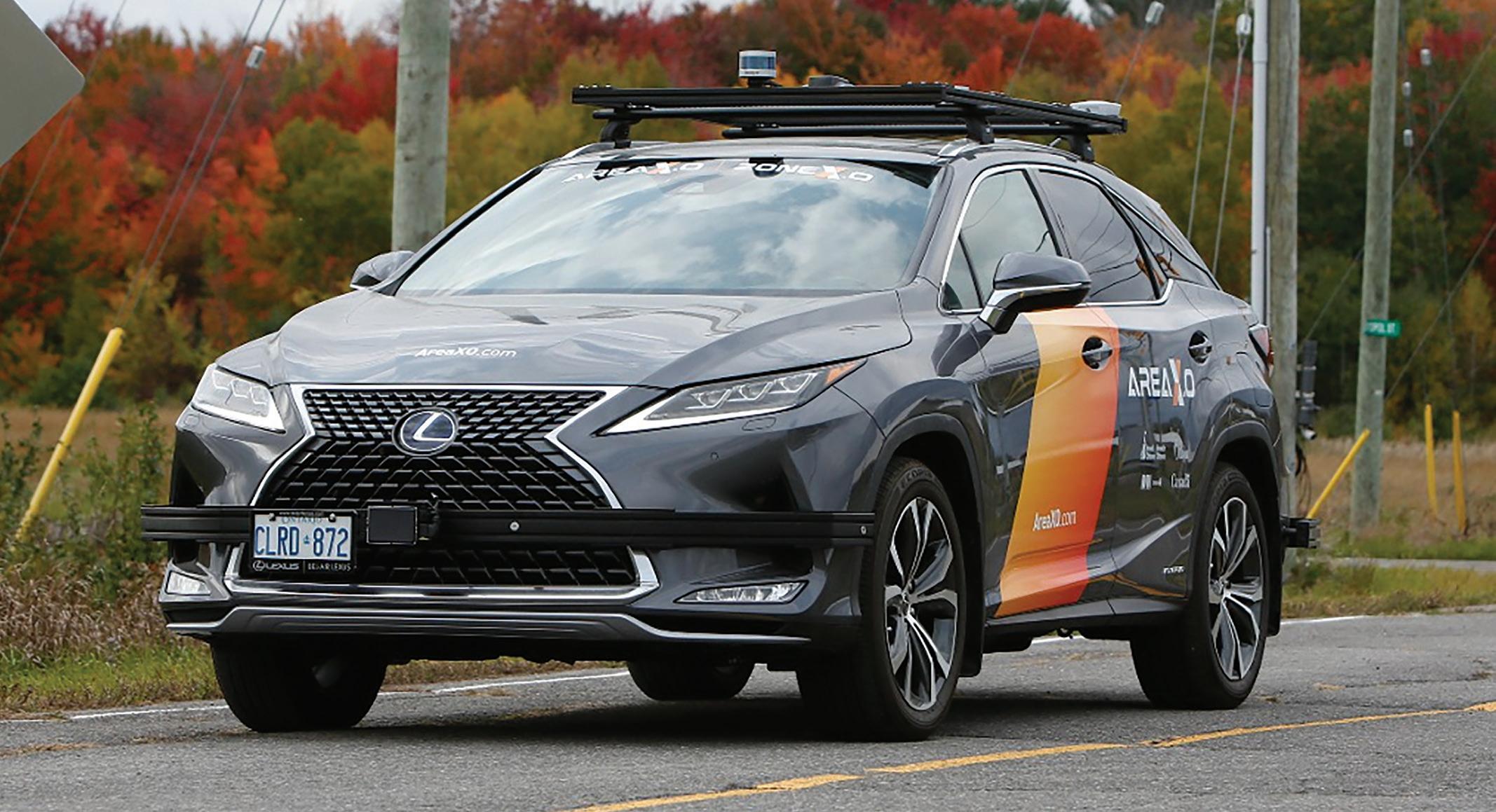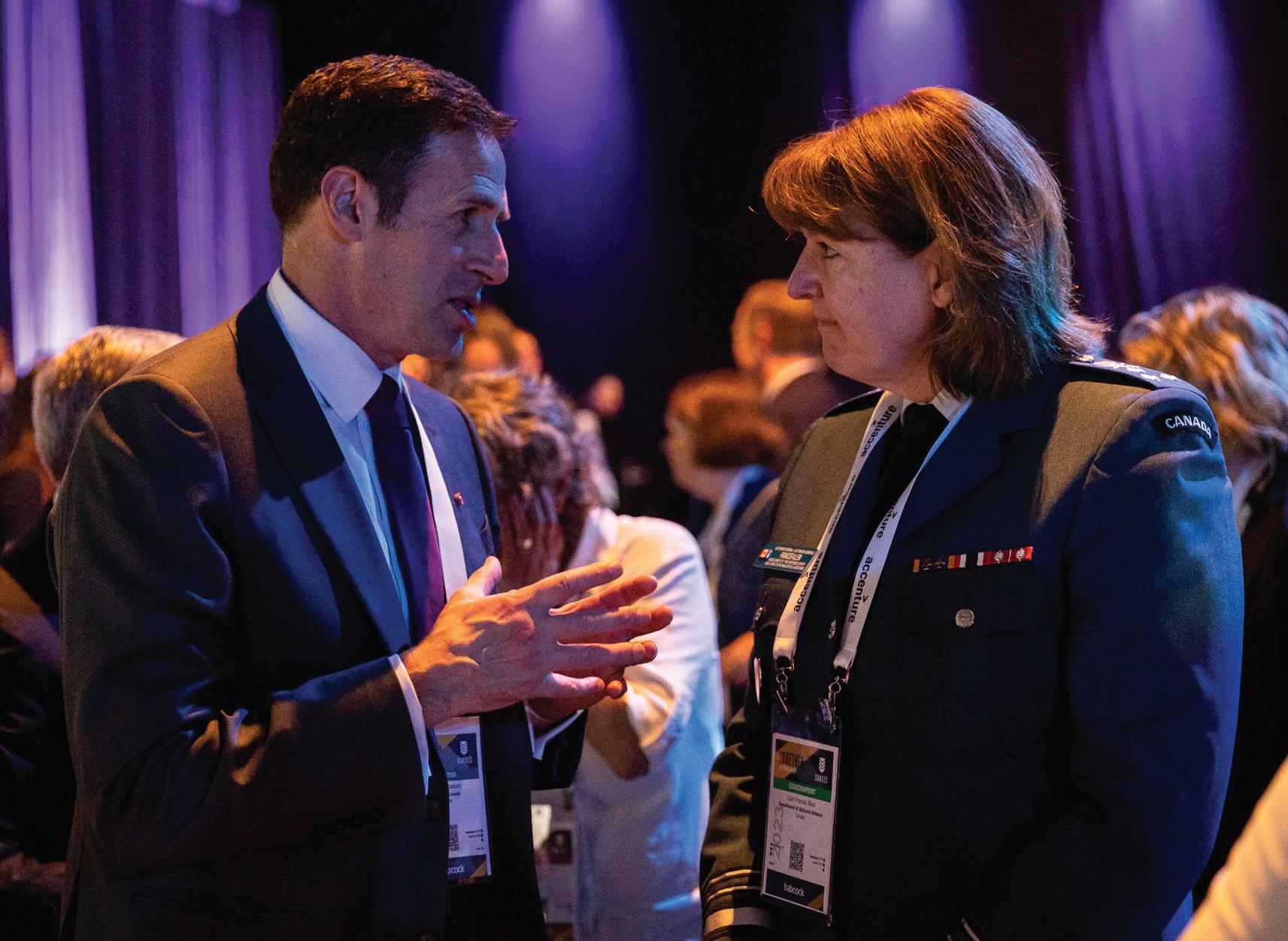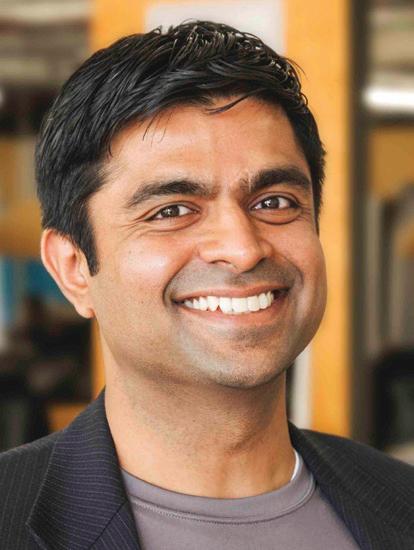



21st Century Security isn’t just an updated system, but a new standard of architecture and open-system integration. Canada and allied partners require deterrence platforms that are interoperable and networked into an ecosystem designed for a new standard of connected protection.
Learn more at lockheedmartin.ca
OBJ.CA SUMMER 2024 2 OTTAWA BUSINESS JOURNAL 2024 DEFENCE AND SECURITY REPORT

CANADA’S DEFENCE INDUSTRY STANDS READY
How business plays a key role
SUMMER 2024 OBJ.CA 3 OTTAWA BUSINESS JOURNAL 2024 DEFENCE AND SECURITY REPORT
Ottawa businesses can play a key role in an evolving national defence sector
BY CHRISTYN CIANFARANI
The past 12 months have brought more news linked to defence than perhaps the entire decade preceding them.
Since the spring of 2023, we’ve witnessed (and this is by no means an exhaustive list) the ongoing fight for Ukraine’s freedom, a near-coup in Russia, cyberattacks on energy companies and critical infrastructure, the worst wildfire season in Canadian history, deadly heat waves, dire warnings about readiness from top leadership within the Canadian Armed Forces, the breakdown of diplomatic relations between Canada and India, the eruption of violence in Sudan, war in the Middle East, aggressive Chinese maneuvers in the air and at sea, and chaos in Haiti.
It’s been a veritable firehose of global and domestic security challenges, capped off in April by the release of an important and long-overdue update to Canada’s defence policy. That update — titled Our North Strong and Free — will serve not only as a guiding document for government and the Canadian military moving forward, but also for the defence industrial base (DIB) as it works to help meet our evolving security needs.
The language contained in the update is clear: a new type of relationship between government and the private sector is required if we are to reform defence procurement, properly equip our armed forces, and fulfill our obligations to alliances such as NATO. In an increasingly unstable world, a healthy and sustainable DIB and sovereign capability in key areas such as cyberdefence are no longer “nice to have.” They are obligatory.
They also happen to have huge, and largely untapped, economic potential. Canada’s defence industry remains in growth mode. Recent data from Statistics Canada shows employment in the industry is up 34 per cent since 2014, export sales are up 28 per cent, and overall revenues have increased by 55 per cent.

The industry’s success is, by extension, Ottawa’s success. This city is home to key federal government departments and agencies responsible for national security, our military headquarters, and many research institutions, making it a natural magnet for defence innovation.
And as defence has evolved to encompass different types of business, so too has the sector’s footprint expanded across the nation’s capital.
In March, NATO announced that its network of test centres for the Defence Innovation Accelerator for the North Atlantic (DIANA) would be growing, and added four Ottawa-based facilities to its roster. Area X.O, the R&D complex operated by Invest Ottawa and focusing on next-generation smart mobility,
autonomy, and connectivity technologies, was one of them.
Drill down into the level of individual products and services and you begin to see how important this ecosystem has become at the local, national and international levels. Unmanned aerial vehicles (aka drones), for example, have widespread defence and civilian applications and are completely redefining the modern battlefield in Ukraine. Those technologies are being developed and manufactured in Ottawa, are being used by the Ottawa Police Service and other regional and municipal partners, and rank among Canada’s top defence exports.
Zooming out to a macro level, productivity in Canada has been lagging for many years, with gross domestic
product per capita declining for the past six consecutive quarters. As government looks to turn the tide, it needs to start “picking winners.” The best way to do that, I’d argue, is to take a hard look at objective criteria such as strong R&D intensity, export intensity, employment in STEM, and clear domestic and global demand for products and services. Canada’s defence sector checks all those boxes, and more.
So as our challenges grow ever more complex and our leaders look for ways to light a fire under the Canadian economy, we should be looking no further than our homegrown defence industry. As always, it stands ready.
Christyn Cianfarani is president and CEO of CADSI.
OBJ.CA SUMMER 2024 4 OTTAWA BUSINESS JOURNAL 2024 DEFENCE AND SECURITY REPORT
“This brings the world to our world and will help bring our companies and their technologies out to the world. I think this is a massive opportunity for us. It really does cement (Ottawa) as a global tech hub.” SONYA SHOREY, INTERIM PRESIDENT AND CEO OF INVEST OTTAWA

Ottawa’s Area X.O, NRC to become global tech testing hubs for NATO network
BY DAVID SALI david@obj.ca
Four Ottawa-area facilities are among 13 sites in Canada that will test nextgeneration defence and security technologies developed by companies from around the world as part of a new NATO program.
The federal government announced recently that Area X.O, an all-weather testing ground for wireless and connected technology in the city’s south end, will join three facilities run by the National Research Council — the Canadian
Photonics Fabrication Centre; the Ocean, Coastal and River Engineering facility; and the Digital Technologies Research Centre — in NATO’s Defence Innovation Accelerator for the North Atlantic (DIANA) network.
“The selection of Area X.O and three NRC labs as NATO DIANA test centres is a testament to Ottawa’s leadership in defence and security innovation,” Ottawa Mayor Mark Sutcliffe said in a statement.
“This global recognition will help drive new business to local companies, accelerate the development and adoption of cutting-edge Ottawa technologies, and
create future jobs that fuel our long-term economic growth.”
The DIANA network aims to bring the best and brightest companies from NATO’s 32 member countries together to develop and commercialize new technologies that will be used for the organization’s defence and security operations, as well as to help tackle global issues such as climate change and food security.
No other Canadian city will be home to more than two DIANA test centres, giving the National Capital Region “a big disproportional advantage” over other parts of the country, said Sonya Shorey,
interim president and CEO of Invest Ottawa, which operates Area X.O.
“This brings the world to our world and will help bring our companies and their technologies out to the world,” Shorey told OBJ. “I think this is a massive opportunity for us. It really does cement (Ottawa) as a global tech hub.”
Two other cities, Waterloo and Dartmouth, N.S., were chosen to host accelerators that will provide specialized programming to companies in the NATOsponsored network.
Shorey noted that NATO countries will be investing “billions of euros” into developing and commercializing new technologies under the DIANA program.
Companies using Area X.O and National Research Council facilities to test their prototypes will likely also be looking to capitalize on Ottawa’s deep-rooted engineering and programming expertise while they’re here, she added, providing invaluable global exposure to local firms.
“It will give us a golden opportunity to attract new global R&D, new business, new talent and investment here,” Shorey said.
“It will inevitably accelerate homegrown technology, commercialization and adoption as we’re working with different companies and innovators. There are always spinoff effects and opportunities.”
Shanaz Sigouin, co-founder and chief administrative officer of Ottawa-based defence technology startup AirShare, called the decision to make Area X.O a test site for technology that will be pioneered by NATO countries a “game-changer” for his company.
“We leverage the unique expertise and capabilities of Area X.O for R&D, testing, validation and demonstration,” said Sigouin, whose firm uses 3D printers to produce guided missiles that are designed to disable drones.
“As a newly minted NATO DIANA test centre, we will have facilitated access to this global network, including prospective customers, talent and collaborators. It will also help us to identify new global markets and revenue streams that propel our growth.”
SUMMER 2024 OBJ.CA 5 OTTAWA BUSINESS JOURNAL 2024 DEFENCE AND SECURITY REPORT
How cyber and emerging technologies are becoming integral parts of defence spending
CANSEC, one of the city’s largest
trade
shows,
ran May 29-30
at the EY Centre. To highlight the growing importance of emerging technologies and broader themes affecting the defence industry, we spoke with Marc Watters, cyberpolicy lead with the Canadian Association of Defence and Security Industries (CADSI).
Q: “Emerging technology” is a term that people hear a lot nowadays and they tend to think of things like artificial intelligence. What does it mean in the context of the defence and security sector?
It used to be that our sector was really focused on traditional defence platforms. So ships, tanks, planes, body armour. And now what we’re seeing is that there’s a huge new focus on a range of technologies that can often be incorporated into those more traditional platforms or projects. It could be clean technology on naval bases, for example, or more advanced stuff like new
health-care technologies. The idea that a soldier might be able to swallow a pill and have it report their vitals to a doctor on the other side of the planet who could give guidance to someone who’s working with that patient on the battlefield. It can also be more obvious things like quantum and, yes, AI, where we’re looking to try to automate a lot of activities or significantly improve the speed of military decision-making.
Q: It sounds like the industry is expanding significantly. Is that a fair assessment?
Oh yes, absolutely. The top companies on
global stock markets are now on our trade show floor at CANSEC. If you went back 15 years, you never would have seen that. The idea that a technology doesn’t belong in defence or national security, I don’t think that’s a reality anymore. There are so many functions that are not defence-specific that are still essential, such as energy security, or even textiles. Name me an industry that has no relevance to defence and I bet you can’t find one. Defence is also an area where we’re going see a lot of government expenditure going forward, so no matter what kind of business you are, you should at least take a look at what’s being asked
for and decide if you can meet that need — because it can be lucrative if you have the patience and the tenacity.
Q: Speaking of planned expenditures, Canada has just come out with an update to its defence policy, a blueprint for the next two decades in defence. How would you say that has been received in the business community?
I know everybody uses the words “cautiously optimistic.” But that’s the prevailing sentiment. There could have been no money, there could have been more cuts given the economic environment in which we find ourselves. So the idea that more than $8 billion in new defence spending is being set aside for the next five years is a strong signal from the government. Obviously one of the big things that industry is wondering — whether it’s the traditional defence firms or newer entrants — is when government

OBJ.CA SUMMER 2024 6 OTTAWA BUSINESS JOURNAL 2024 DEFENCE AND SECURITY REPORT


changes over, is this investment going to be carried through? Digital intelligence collection and analysis and some of the core defence technologies, that’s where I think we’re going to see money spent over the next two years. For emerging tech firms, it’s encouraging to see that coming out the door first.
Q:There do seem to be more public conversations happening around defence lately in Canada. What’s that in response to?
I think that, even though we don’t know whether Donald Trump is going to become president in the U.S. again, when he makes statements like, “Well, we might not come to your aid if you don’t get serious about defence” it sends a message that Canadians understand. We don’t want to be seen as not pulling our weight. And so our government is stepping forward and making an unequivocal statement to our allies. That we take defence seriously. That we are going to make investments. That we plan to follow through, because we want to be seen to be doing our part. That’s also a very strong message for industry to receive.
Q: It’s one thing to receive it and another to be able to act on it. What supports do businesses need to “seize” this moment?
The first is protection. Foreign adversaries are infiltrating all sorts of different institutions in Canada, whether they be academic, research-based, or in defence.
They’re pulling out intellectual property in our sector and patenting it back in their own countries, which obviously has a negative economic impact. But more importantly, if adversaries already understand how we operate and where our weaknesses are, we can be out-competed in the battle space, which could result in loss of life. And that’s when it gets serious. I think it’s critical that the government works with the defence industry to provide proper services and supports. The Canadian Centre for Cybersecurity recently stood up a team dedicated to protecting the defence industrial base, and that’s a good start.
Second, as an organization, CADSI is working hard to identify and respond to the evolving needs of our members. Companies want to be connecting with the customer, obviously, and that’s why we have things like the CANSEC Labs and B2B/B2G meeting program at CANSEC, plus attendance at international defence shows. But firms also have policy concerns and part of my role is to ensure that the ones specific to cyber and emerging technology are being heard on Parliament Hill. We have an internal member committee called the Cyber Council for that purpose.
Finally, industry still doesn’t have a sense — especially in the advanced technology space — of the types of technologies or relationships that government wants to advance with us. We’re missing an entire ecosystem for understanding what the needs are, communicating those needs clearly with

strong demand signals to industry, and then aligning the policy and regulatory environment to facilitate these interactions.
Q:I understand CADSI has an event planned for early November called the Cyber and Digital Outlook. What do you hope to accomplish, especially as Canada works toward building that ecosystem?
This event is brand new and is partially modelled on our existing Canadian Armed Forces Outlooks in the spring. We’ll be welcoming representatives from various government departments
with responsibilities linked to cyber and emerging tech to speak directly with industry. To say: “Here’s the sort of technology I want to acquire. This is how we’re thinking of working with you. This is how we’re going to test and onboard your technology. This is how we want to be able to deploy.” That will be beneficial to both sides and allow an exchange of ideas. We hope that could evolve into more regular touchpoints and new approaches to procurement. Maybe looking at prototypes and viable models rather than RFPs that are 100 pages long. There’s a lot of work to do in this space, but also huge opportunity.
SUMMER 2024 OBJ.CA 7 OTTAWA BUSINESS JOURNAL 2024 DEFENCE AND SECURITY REPORT
CLOCKWISE: Vice-chief of the defence staff Lt-Gen. Frances Allen (centre) explores the CANSEC Labs in June 2023. CADSI senior policy adviser Marc Watters chats with a member during the recent Canadian Armed Forces Outlooks in Ottawa. Lt-Gen. Allen chats with Microsoft’s Derek Dobson during CANSEC 2023. PHOTOS COURTESY OF CADSI
Navigating Through Disruption: Ottawa Company Zighra’s AI Technology On Guard For Canada
In an era when geopolitical tensions simmer and technological warfare advances, the specter of GPS (Global Positioning System) jamming and spoofing poses a silent yet formidable threat. These sophisticated cyberattacks disrupt everything from daily communications to critical defense operations, highlighting vulnerabilities in global security infrastructures. Ottawa-based Zighra stands as a beacon of innovation, deploying AIdriven solutions that detect, understand, decide, and act against such dangers. With a deep understanding of the stakes involved, Zighra’s cutting-edge technology not only enhances Canada’s defense capabilities but also actively shapes a resilient future in a world where digital warfare knows no boundaries.
Zighra’s Strategic Solutions in Action

Advancing Canada’s Defense with Cutting-Edge AI Technologies
Amid increasing global unrest and threats from both state and non-state actors, Canada’s Department of National Defence and the Canadian Armed Forces are advancing toward becoming AI-enabled by 2030. Despite this proactive stance, there remains a perception that Canada lags in adopting advanced defense tactics. Zighra is determined to change this narrative by leveraging its highly cited patents and its extensive experience with leading financial institutions worldwide.
Leading the Shift Towards Transparent and Accountable AI
Zighra ensures that every decision made by its systems is traceable and justified. “The trust in AI systems by operators, commanders, and eventually citizens hinges on our ability to explain how decisions are made,” says Deepak Dutt, CEO of Zighra. “Our commitment to explainable and ethical AI applications sets a new standard in the defense sector.”
Zighra is transforming defense capabilities with its latest innovation, GenesysInsights. This advanced AI-driven platform leverages cuttingedge machine learning algorithms, including real-time data fusion and behavioural analytics, to address a wide spectrum of security challenges. GenesysInsights is distinguished by its capability to analyze and synthesize data from disparate sources, such as satellite imagery and direct sensor inputs, offering decisionmakers unparalleled situational awareness. Its unique feature includes an adaptive learning engine that continually evolves, ensuring that the system stays effective as new threat patterns emerge. With its robust integration capabilities, GenesysInsights seamlessly fits into existing national defense infrastructures, enhancing operational efficiencies without the need for extensive overhauls.
Enhancing Maritime Security
One of the most pivotal applications of GenesysInsights has been its rapid experimentation with a national maritime agency. This collaboration has been fundamental in enhancing maritime security, providing comprehensive situational awareness by integrating data from multiple sources, including satellite data, terrestrial AIS (automatic identification system), and direct inputs from shipboard sensors. The platform offers a realtime analytical view that is crucial for the safety and operational efficiency of maritime activities.
From Idea to Implementation: The Zighra Edge
“We developed our platform to combat AIpowered threats, integrating diverse sensors to enhance our detection capabilities,” explains Dutt. “Our customers are particularly impressed with our ability to detect anomalies across
different sensors, significantly enhancing the security of ports against cyber and radio frequency attacks.”
Within just five months, this pilot project with the national maritime agency demonstrated Zighra’s rapid developmental prowess, transitioning from concept to full-scale implementation. This not only fortifies maritime security but also exemplifies Zighra’s capability to generate and deploy innovative technologies like GenesysInsights rapidly.
Zighra’s Path Forward and Harnessing Elite Talent
Zighra’s team, featuring top-tier researchers from prestigious institutions like Nvidia labs in Toronto, the University of Waterloo, Massachusetts Institute of Technology, and Carleton University is pivotal in rapidly turning innovative concepts into real-world solutions. This elite talent pool addresses complex defense challenges swiftly and effectively.
With over a decade of experience, 15 patents, and impactful citations from industry giants like IBM and Google, Zighra is actively expanding its reach. The firm has harnessed strategic procurement vehicles under the Innovative Solutions Canada (ISC) program, such as the Pathway to Commercialization, enabling it to quickly bring its solutions from the laboratory to real-world defense applications. This capability not only positions Zighra at the forefront of Canadian defense technology but also showcases its role on a global stage, including advancements in cybersecurity and GPS Navigation Warfare.
As digital threats continue to evolve, so does the landscape of defense technology. Zighra remains at the forefront, continuously advancing its AI solutions to meet emerging challenges. With ambitious projects on the horizon and ongoing enhancements to GenesysInsights, Zighra is committed to leading innovation in resilience and security. This proactive approach not only safeguards Canada’s interests but also contributes to global stability in an increasingly interconnected world.
OBJ.CA SUMMER 2024 8 OTTAWA BUSINESS JOURNAL 2024 DEFENCE AND SECURITY REPORT
CONTENT
SPONSORED
Deepak Dutt, CEO, Zighra.












